Horse News
Member
Managing Petite Horse Properties
When you think of owning a horse farm, you probably imagine acres of rolling fields, green with lush grass.
In reality, large properties are unaffordable to the majority of equestrians. Fortunately, there’s plenty you can do to make a smaller property horse friendly.
A small property that is well-managed can work just as well as a larger one. The key is to keep pastures dry clean and maintain paddocks that can be used to help save grass. Mud and manure are two of the biggest issues. Fortunately, both can be managed with a little extra planning.
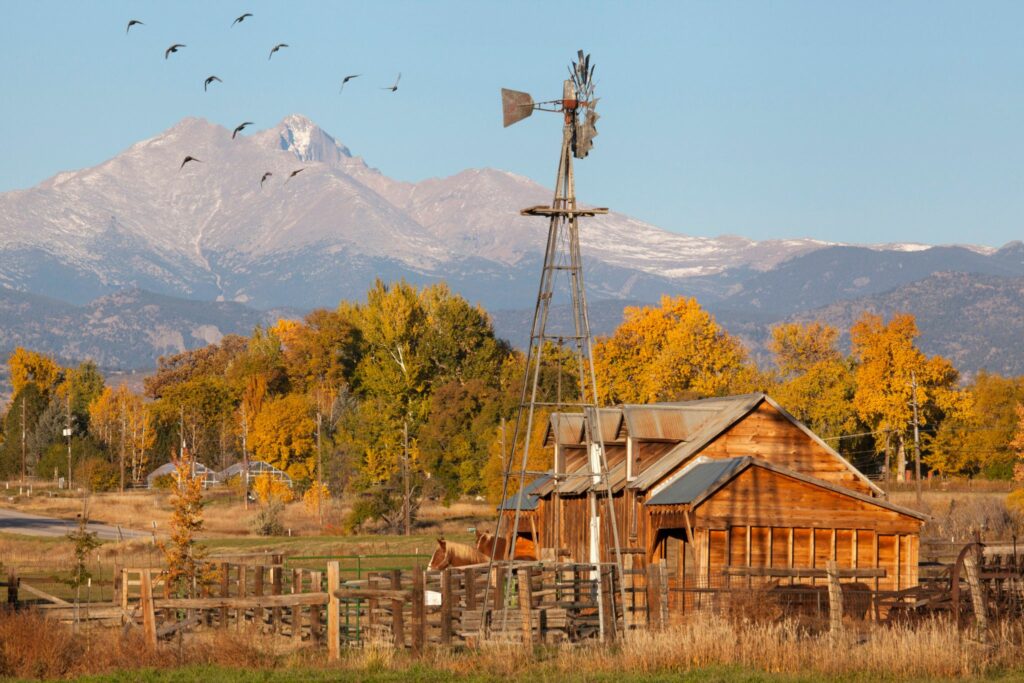
Source: Canva
Owning A Small Horse Farm
Owning a small horse farm is a dream many equestrians have at one point or another. After all, who doesn’t love the idea of waking up and seeing your horse in the backyard?
Thanks to limited space and high real estate prices, the small farm has become the new large property, and many horse lovers are making it work with much smaller spaces (some as tiny as one acre!).
Small Is the New Standard
With horse owners living across the country, from urban to suburban to rural, small has come into fashion. Some owners make do with as little as one or two acres.
After all, a well-designed two-acre property may be better off than a poorly managed ten-acre one!
Defining Small Acreage
A small acreage farm is generally considered to be ten acres of land or less. Horses can adapt to less space, however. As long as you manage the land well and give your horse plenty of exercise, he won’t notice the difference.
You could also define ‘small acreage’ as anything less than one acre—per horse.
A long-standing rule of thumb for minimum horse farm size is one acre of land per horse. For example, fifteen acres is a good size but counts as a small acreage if you keep twenty (or more) horses on it.
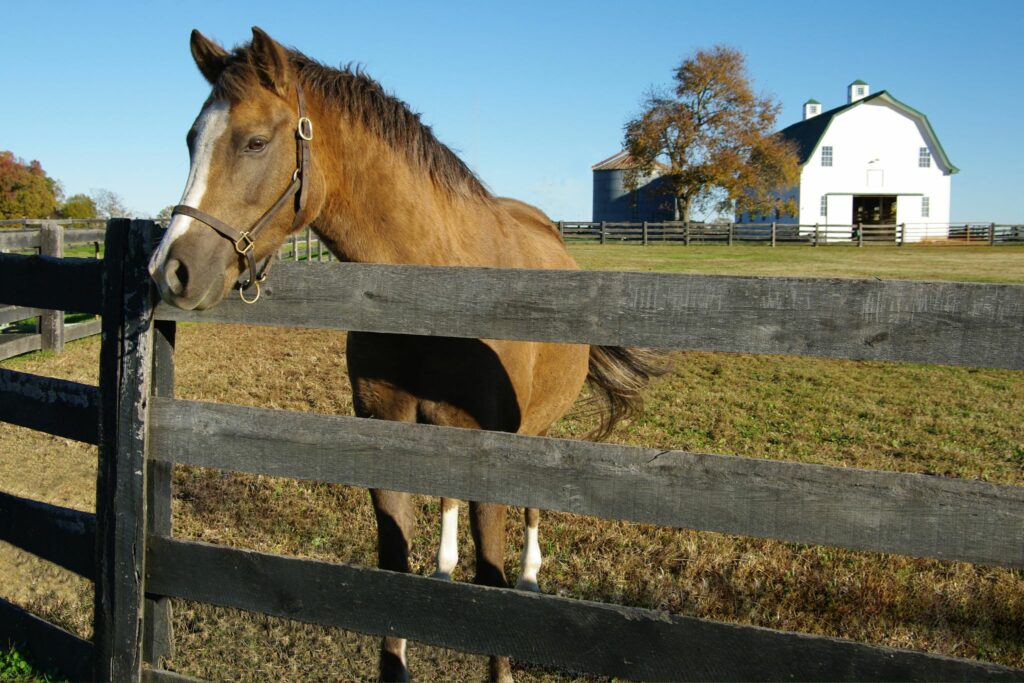
Source: Canva
Benefits to Small Acreage Properties
Less acreage is both more affordable and easier to maintain. For example, you don’t have to walk as far to turn your horses out!
In some cases, spaces can do double duty (like using a riding space for turnout). Smaller acreage properties also force you to think about what you really need for your horses and help you minimize design (while maximizing efficiency).
Challenges to Small Acreage Properties
Of course, a small acreage property comes with a unique set of challenges.
Growing a pasture free of weeds, minimizing mud, managing manure, and giving your horse enough exercise are the biggest ones.
Pasture Management
Maintaining a pasture for horses is different than just maintaining a field of grass. The goal is to have a full green cover that is free of weeds and has little to no mud.
Obtaining nutritional needs from grass alone on a small acreage is almost impossible, so plan to feed hay and grain (or a ration balancer).
Ideal Pasture Per Horse
The ideal pasture size is two to four acres per horse (if you want them turned out and grazing 24/7). Many owners make do with less, aiming for one acre per horse.
The more horses you have per acre, the less effective the grass will be.
Smaller properties often have only one small grass space for occasional grazing and the rest of the turnouts are dry lots or dirt.
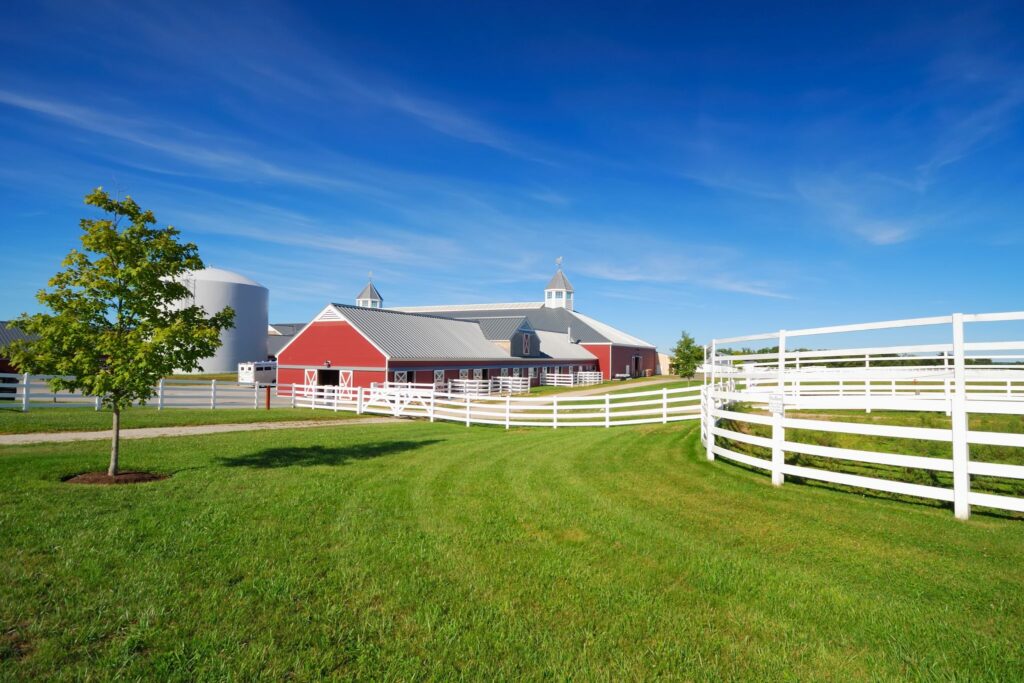
Source: Canva
Managing Small Pastures
To maintain a small pasture, you’ll need to limit turnout and minimize any rambunctious behavior (it tears up the ground). You’ll also need to clear the manure regularly (a minimum of two times per week).
To protect the grass, avoid using pastures when wet, as horses will tear up the turf faster when saturated. It also helps to include a buffer of grass or other vegetation around the pastures to help with runoff.
Managing With No Pasture
It’s also possible to manage a horse farm with no pasture. In fact, some owners find this easier. Just plan for enough room for hay storage and consider building a shelter in your turnouts to help keep the hay dry.
Paddock Management
Managing a paddock has similar requirements to managing a pasture. You want to keep it dry, free of manure, and make sure it’s large enough for the number of horses using it.
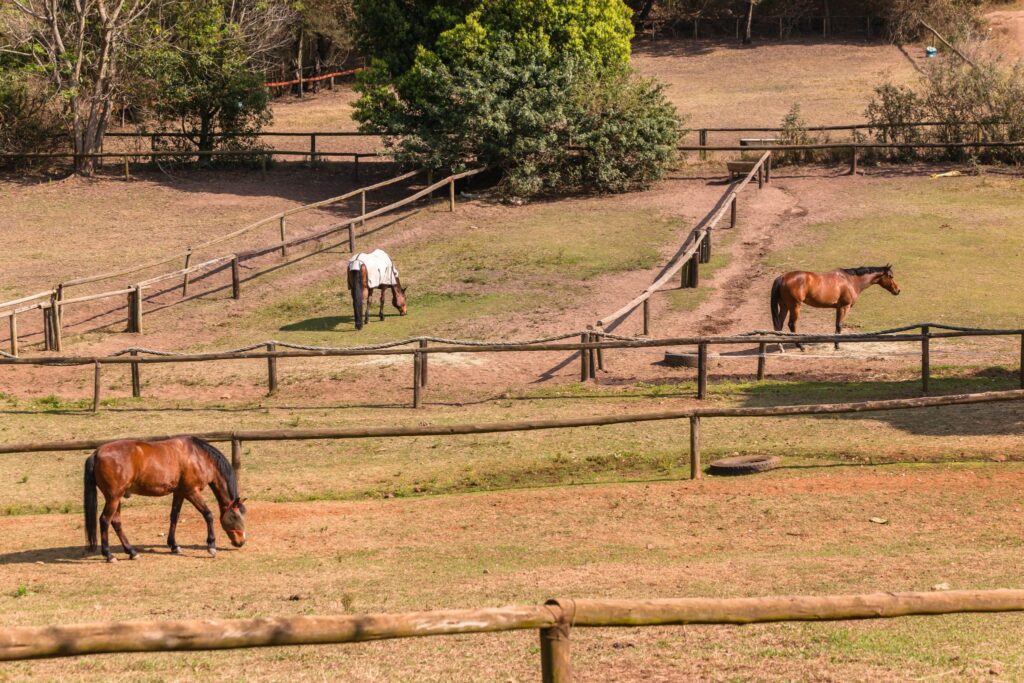
Source: Canva
Ideal Paddock Size Per Horse
Allow a minimum of 300 to 400 square feet per horse (600 square feet for larger horses). Some horses do fine in a space that’s sixteen-by-sixteen feet (or the size of a large stall).
If you want a paddock for playing and running, aim for around twenty to thirty feet wide by around one hundred feet long.
Dual Purpose Spaces
In the smallest of acreages, your turnout may also be your riding arena. If that’s the case, clear it of manure every day, and consider installing a drainage system.
This article offers great tips for minimizing mud in paddocks. If you have a round pen, it could also double as turnout on wet days to help save your pastures.
Mud Management
Mud creates bigger problems than wet feet and a dirty horse. Fungus and bacteria often live in mud and can cause health problems, and prolonged exposure to mud can damage your horse’s sole and hoof.
Mud Hacks
To minimize mud, you may have to limit turnout during the wet season and use a paddock or dry lot instead. Choose a location on high ground to avoid flooding. Some areas may need to include layers of stones, pebbles, and sand to help keep the area dry.
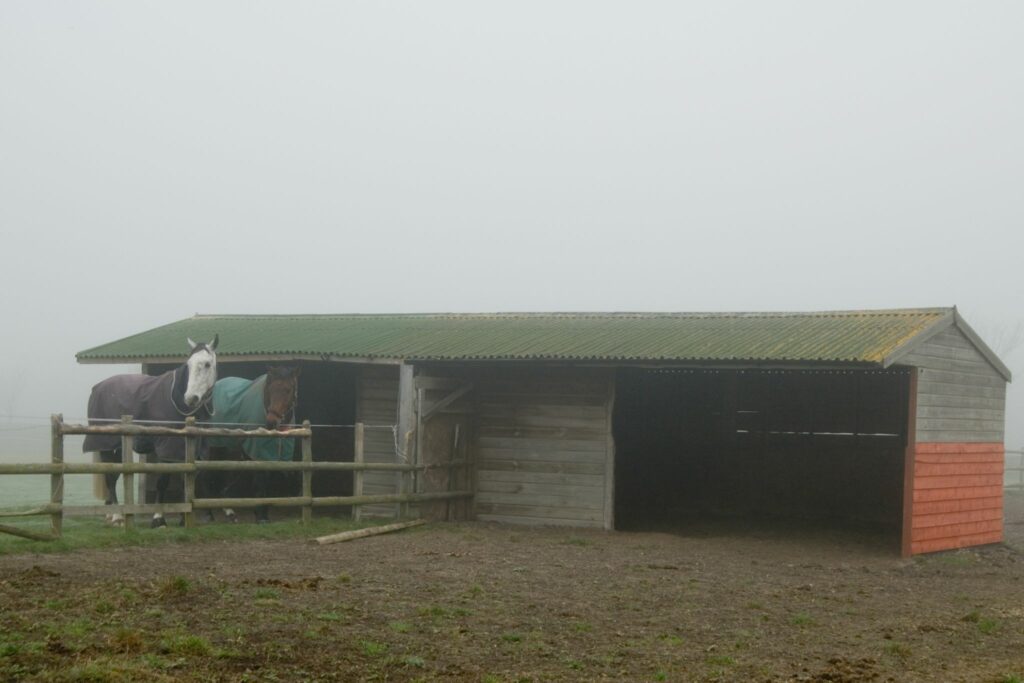
Source: Canva
Mistakes To Avoid
Giving your horse unlimited access to your pasture means the pasture will likely degrade quickly.
Especially during the wet season, limit turnout and don’t let your horse run (it tears up the grass and makes it easier for the mud to become a permanent problem).
Manure Management
Manure is a problem on any size farm but can prove a real challenge on farms with limited acreage. The average horse will produce forty to fifty pounds of manure every day, and it has to go somewhere.
Cleaning Frequencies
Pastures should be cleared of manure every one to three days. This prevents a gross, soup-like top layer and inhibits parasite growth.
On-Site Management vs. Hauling It Away
If you want to manage your manure on-site, composting is a great choice. You only need three things for a successful compost pile.
- Air: Air helps bugs and microbes transform manure into fertilizer. You can achieve this by tossing your pile once a week with a pitchfork or tractor.
- Moisture: Microbes need a moist environment to function. The best way to check is to grab a handful from the pile and squeeze (it should feel like you’re squeezing a damp sponge). Too dry? Add some water. Too wet? Cover the pile with a tarp.
- Carbon to Nitrogen ratio: This ratio is why it’s important to minimize how many shavings end up in the pile. If you frequently dump stall cleanings in, also add in some grass clippings to help balance this ratio.
Another option to manage manure is to haul it away. Most areas have at least one private hauler who can come weekly or monthly. Some companies even provide a bin they will take and replace. You could also reach out to local farmers. Farmers love horse manure as it makes for great fertilizer.

Source: Canva
Frequently Asked Questions
Q: How do you keep horses on a small acreage?
Horses can be just as happy on a small property as on a large one. To make horses work with small acreage, it’s all about properly managing your available space.
Keep pastures and paddocks free of manure and dry. Adding a buffer strip (usually grass or some other horse-safe vegetation) around these areas can help prevent runoff. If you have more than one horse per acre, grass will be a supplement and not a main diet component, so plan to feed (and store) hay.
On smaller acreages, if your horse has less turnout time, make sure they can still get adequate exercise.
Q: Can you keep 2 horses on 1 acre?
Absolutely! Just make sure the two horses get along, as smaller spaces can lead to more fights. Aim for at least two fields so you can rotate between them (especially if you want one or both fields to have grass).
Also, know that with this size, you’ll definitely have to feed hay.
You may also want to dedicate a “sacrifice” area (a place grass will never grow due to frequent use) to help avoid tearing up any grass spaces or to use when the larger turnouts are muddy/wet. With just one acre, you’ll also need to clean up manure every day (some owners find picking in the morning and evening makes managing the manure easier).
Q: Can you have a horse on 1 acre?
A horse can be managed on one acre. Ideally, you can separate this acre into three sections: one for pasture, one as a paddock, and one as a sacrifice space. Rotate between the pasture and paddock, making sure the grass doesn’t get below three inches long.
Q: Is 2 acres enough to support 2 horses?
Two acres can definitely support two horses! This depends, however, on how much of those two acres is actually for the horses. For example, if you buy a two-acre property and put up a house, a barn, a storage shed, and a riding arena, you’re down to just one acre.
One way to make this work is to have your riding space double as a turnout space. Make sure to keep it free of manure and consider installing some rocks and gravel beneath the sand or dirt to improve the drainage and help keep it dry.
Q: How many acres do you need to support 2 horses?
Ideally, you would want three to four acres to support two horses. If you want your pasture to support your horses full-time, aim for eight to ten acres. Of course, some owners make do with as little as one acre. It really comes down to how well you manage and maintain the space.
Q: What is the minimum size for a horse paddock?
Ideally, aim for a minimum size of fifty-by-fifty feet. A paddock should be a minimum of 300 to 400 square feet per horse, 600 square feet for larger horses or drafts. In spite of that goal, some owners use smaller paddock turnouts that are sixteen by thirty-two feet.
If you want enough space for your horse to be able to run, a good minimum size is twenty by one hundred feet.
Q: Can you keep a horse on a ½ acre?
It can be done, but this size is less than ideal (and zoning and agriculture laws in some areas may not allow it). If the ½ acre is just for a horse (and doesn’t include space for a house or any outbuildings), it works if you keep it clean and dry and supplement your horse with hay. Most horses need a minimum of one acre, however, to have enough space.
If you only have a ½ acre to work with, consider building a track system. Picture a rectangle with a smaller rectangle inside it. In the small rectangle, you would grow/maintain grass (to use on a limited basis). The horse is then turned out in the space between the small and large rectangle.
To maximize your horse’s exercise, place one flake of hay around the “track” (or the ground or in hay bags) to encourage him to walk around. You’ll also need to clean out the manure every day to help maintain the paddock.

Source: Canva
Parting Thoughts
While you may be wishing for a 100-acre paradise, it’s possible to get the horse farm of your dreams for much less acreage. With a bit of extra planning and work, small farms can be every bit as nice as the larger ones (and easier to maintain).
Small acreage doesn’t have to be limiting if you know how to make the best use of the space.
P.S. Enjoy this article? Trot on over to:
- Equine Shelter 101: Do all horses need a stable?
- What is a horse house called?
- Stay Put, Pony! Horse Stall Guards for Beginners
- 7 Best Boredom Bustin’ Horse Pasture Toys
- Horse Run In Sheds for Beginners (Cost, Size, etc.)
- Horse Hay FAQs: List of Types of Hay, What Hay is Best, etc.
- Food or Foe: What Do Horses Eat (And Why)
- How Horses Sleep: A-Zzz Guide to Equine Rest
Sources
Managing-Small-Acreage-Horse-Farms-3.pdf (wmswcd.org)
The post Less is More: How to Keep Horses on Small Acreage appeared first on Horse Rookie.
Continue reading...
